A Comparative Study of En Route Refuelling Behaviours of Conventional and Electric Vehicles in Beijing, China
Abstract
1. Introduction
1.1. Background
1.2. Previous Studies of Refuelling Behaviour
1.3. Data Collection Methods for Refuelling Behaviour Analysis
1.4. Comments on Previous Work
2. Methodology
2.1. Questionnaire Design
- Scenario 1 (PHEVs): Given that the driving range of PHEV was 50 km and their PHEVs were about to use up their electricity;
- Scenario 2 (BEVs): Given that they were about to use up their electricity but were about 25 km away from the next charging facility.
2.2. Survey Design
2.3. Relating Refuelling Behaviour to Individual Attributes: Multinomial Logit (MNL) Model
3. Survey Results
3.1. Maximum Acceptable Time of Diverting to a Station for En Route Refuelling
- (1)
- CV. The z value of household income is −2.06, suggesting that household income is a statistically significant factor that could heavily influence the individual choice of the diverting time. Specifically, people with a higher household income are more unlikely to choose Choice 2 (=5 min), which is also shown by Figure A1 (in Appendix B) presenting the relationship between the diverting time and household income.
- (2)
- PHEV. The diverting time of PHEV drivers is only associated with the highest level of education. Specifically, people with higher education level are more likely to choose Choice 4 that is 15-min diverting time, according to the z value of 2.08 and Figure A2 (in Appendix B) showing the relationship between the diverting time and the highest level of education. This may be because people with higher level of education tend to have higher environmental awareness and thus be more willing to use electricity.
- (3)
- BEV. BEV drivers with higher individual income are more likely to choose 3 min or 15 min as their maximum acceptable diverting times, as evident from both the z values and the relationship shown by Figure A3 (in Appendix B). Again, this may be because some of the people with higher income would like to save more time, and the others may have a stronger desire to use electricity because of their higher environmental awareness.
3.2. Maximum Acceptable Time of Waiting at a Station for En Route Refuelling
- (1)
- CV. Both household income (z = −2.5) and individual income (z = 2.08) are identified as statistically significant variables, but they have opposite relationships with waiting time. Specifically, people with higher individual income tend to choose the Choice 2 of 3 min (see Figure A4 in Appendix C) as these people may have higher time values and do not want to wait for a long time, while people with higher household income have the opposite tendency. This opposite tendency suggests that people with higher household income may not have high time value and are different from those people who themselves have high income.
- (2)
- PHEV. The statistically significant variables for PHEVs include the number of vehicles owned (z = 2.3), the highest level of education (z = −2.26), household income (z = −1.99) and age (z = 2). The following conclusions can be drawn based on both the model coefficients and the relationships shown by Figure A5 (in Appendix C): (1) older people tend to choose the Choice of 3 min and do not want to queue for a long time, while people with higher household income tend not to choose the Choice of 3 min; (2) people with more vehicles tend not to queue at stations (or to choose Choice 1 = 0 Min); In contrast, people with higher level of education are likely willing to queue (or not to choose Choice 1 = 0 Min).
- (3)
- BEV. The number of driving licenses owned (z = 2.05) is the only statistically significant variable for BEVs. Specifically, the more licenses owned, the more likely the people choose not to queue at charging stations, according to both the model coefficients and Figure A6 (in Appendix C).
3.3. Refuelling Refuelling Modes of CV and PHEV
3.4. Obtained Electric Driving Ranges of PHEV and BEV
4. Potential Applications of Empirical Findings in Infrastructure Planning
5. Conclusions
Author Contributions
Funding
Conflicts of Interest
Appendix A. Examining Survey Bias
| Individual Attributes | Actual Distribution | Reference Distributions | |
|---|---|---|---|
| Sex | Male | 61.3% | 51.0% |
| Female | 38.7% | 49.0% | |
| Age | <18 | 0.3% | 24.2% |
| 18–24 | 16.4% | ||
| 25–34 | 46.5% | 22.0% | |
| 35–44 | 24.6% | 16.4% | |
| 45–54 | 10.3% | 15.5% | |
| 55–64 | 1.7% | 12.1% | |
| >65 | 0.2% | 9.9% | |
| Income (RMB) | <3000 | 9.0% | 11.1% |
| 3001–4500 | 11.1% | 12.2% | |
| 4501–6000 | 18.8% | 18.7% | |
| 6001–8000 | 19.8% | 18.5% | |
| 8001–10,000 | 16.2% | 10.5% | |
| 10,001–15,000 | 14.7% | 12.7% | |
| >15,000 | 10.5% | 13.3% | |
Appendix B. Figures for Maximum Acceptable Diverting Time
Appendix B.1. CV Diverting Time
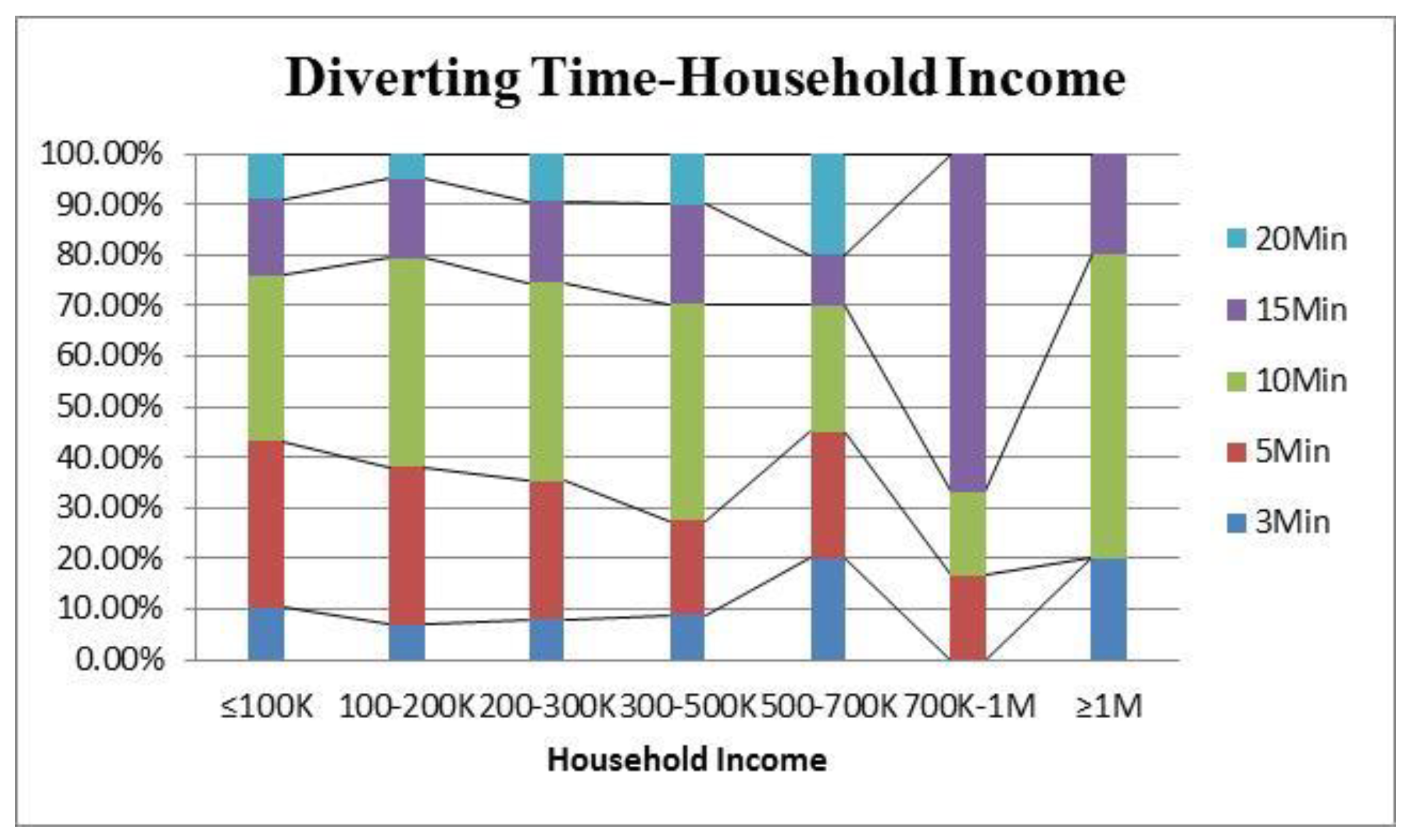
Appendix B.2. PHEV Diverting Time
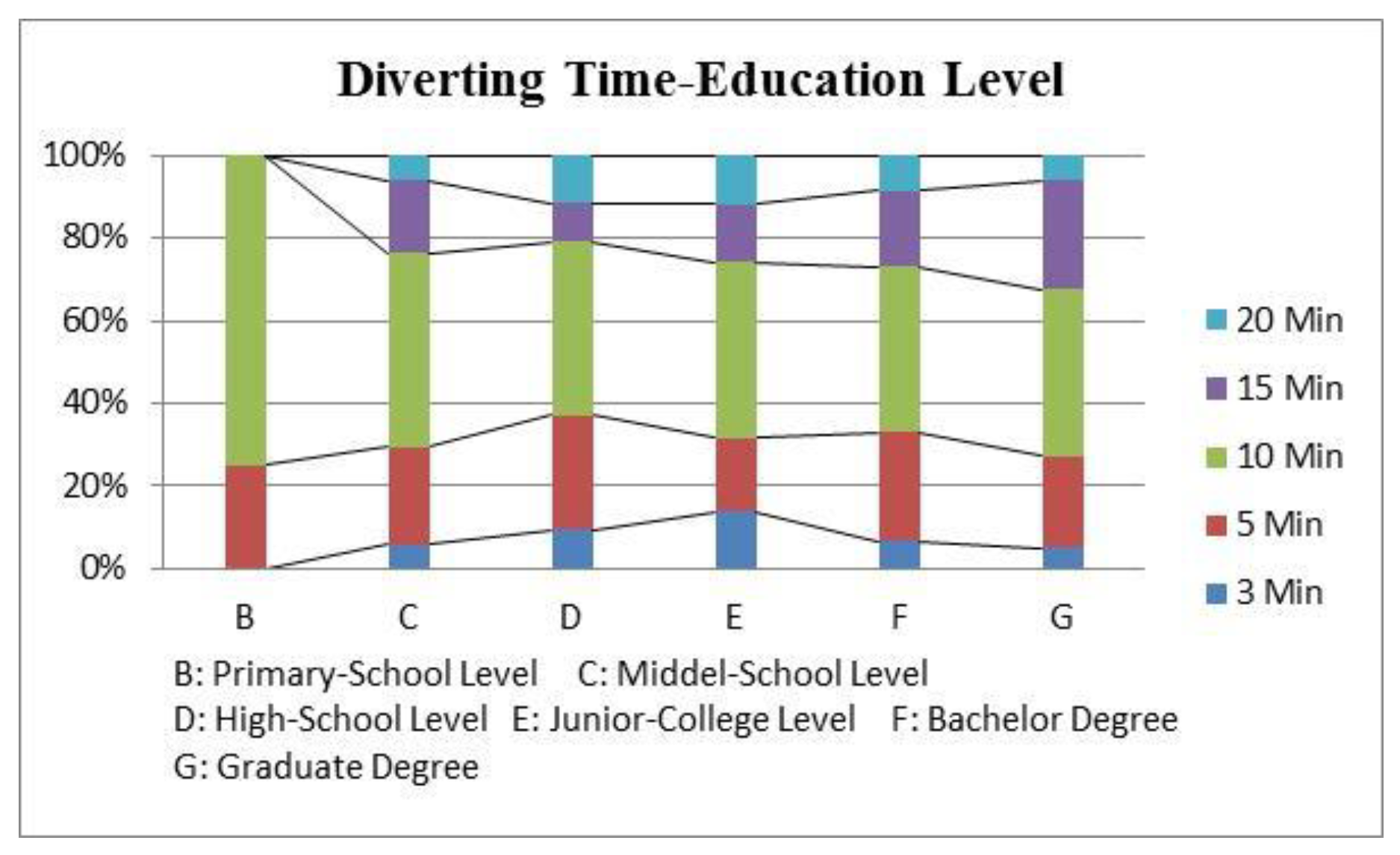
Appendix B.3. BEV Diverting Time
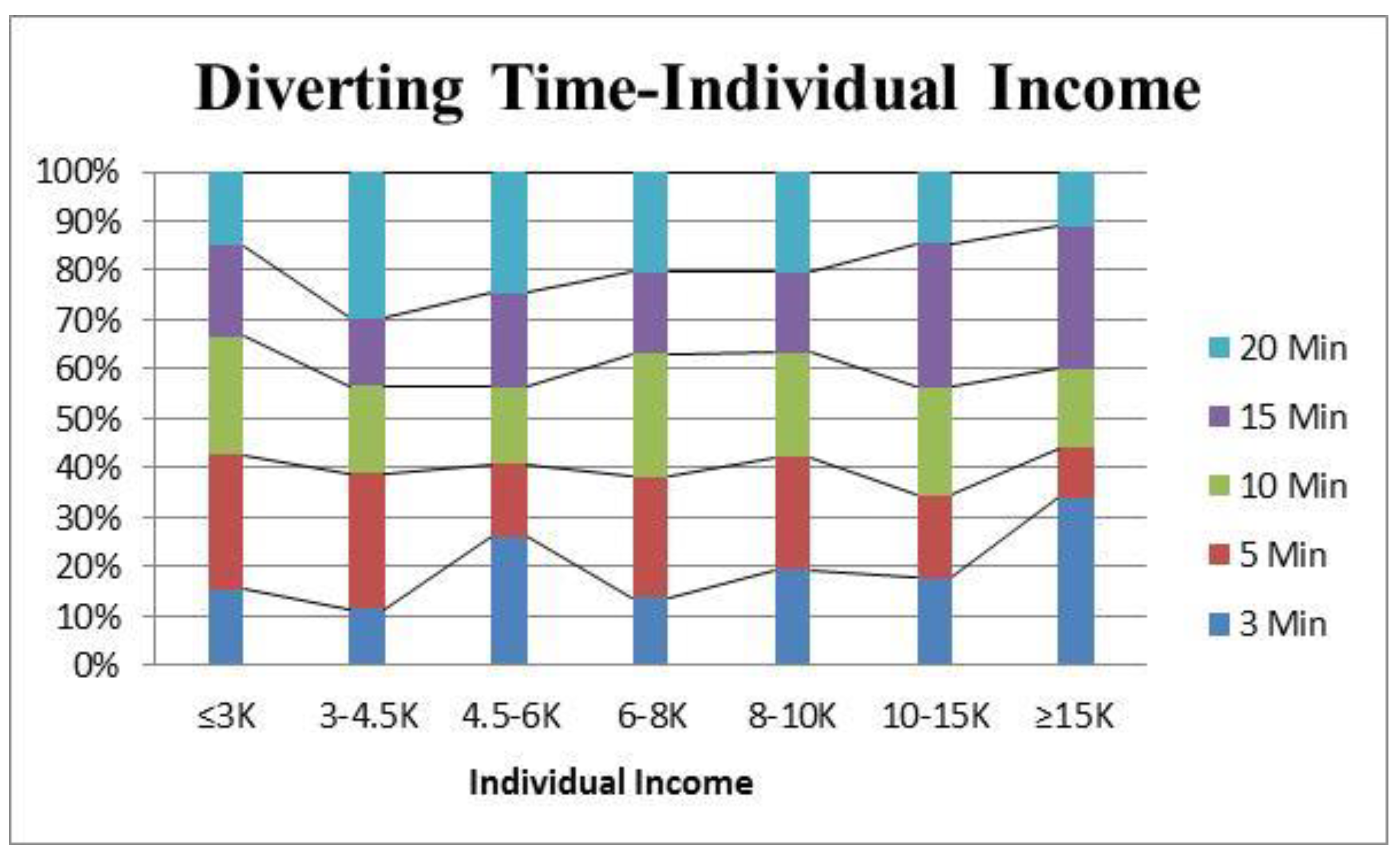
Appendix C. Figures for Maximum Acceptable Waiting Time
Appendix C.1. CV Waiting Time
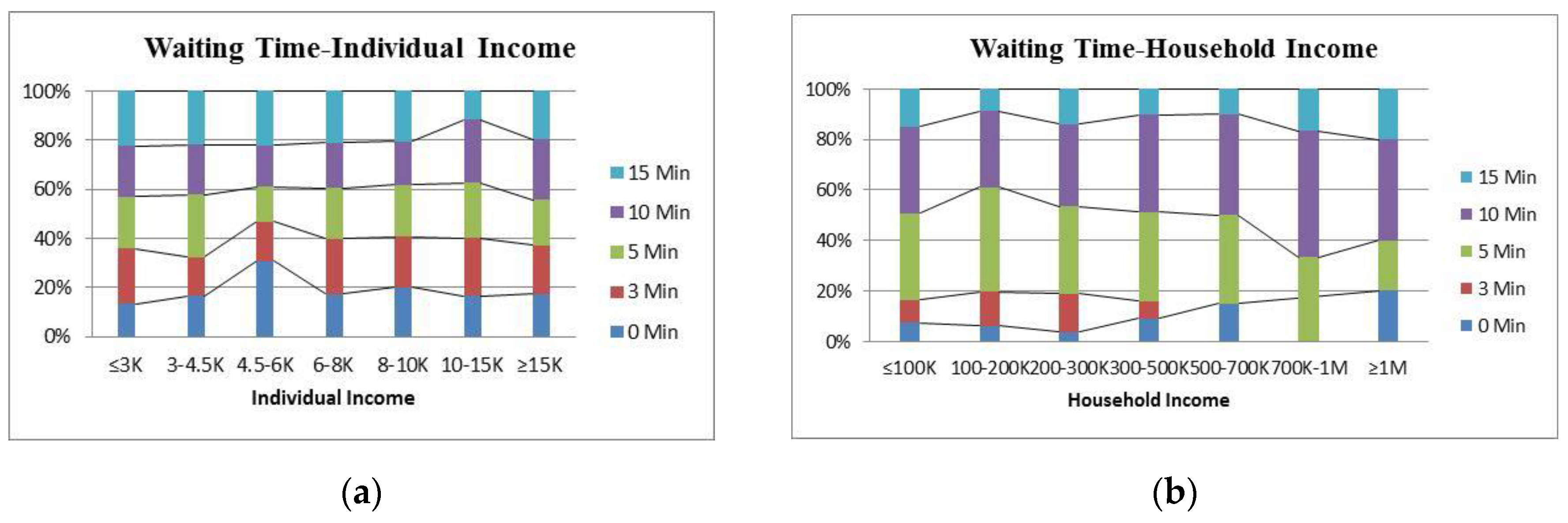
Appendix C.2. PHEV Waiting Time
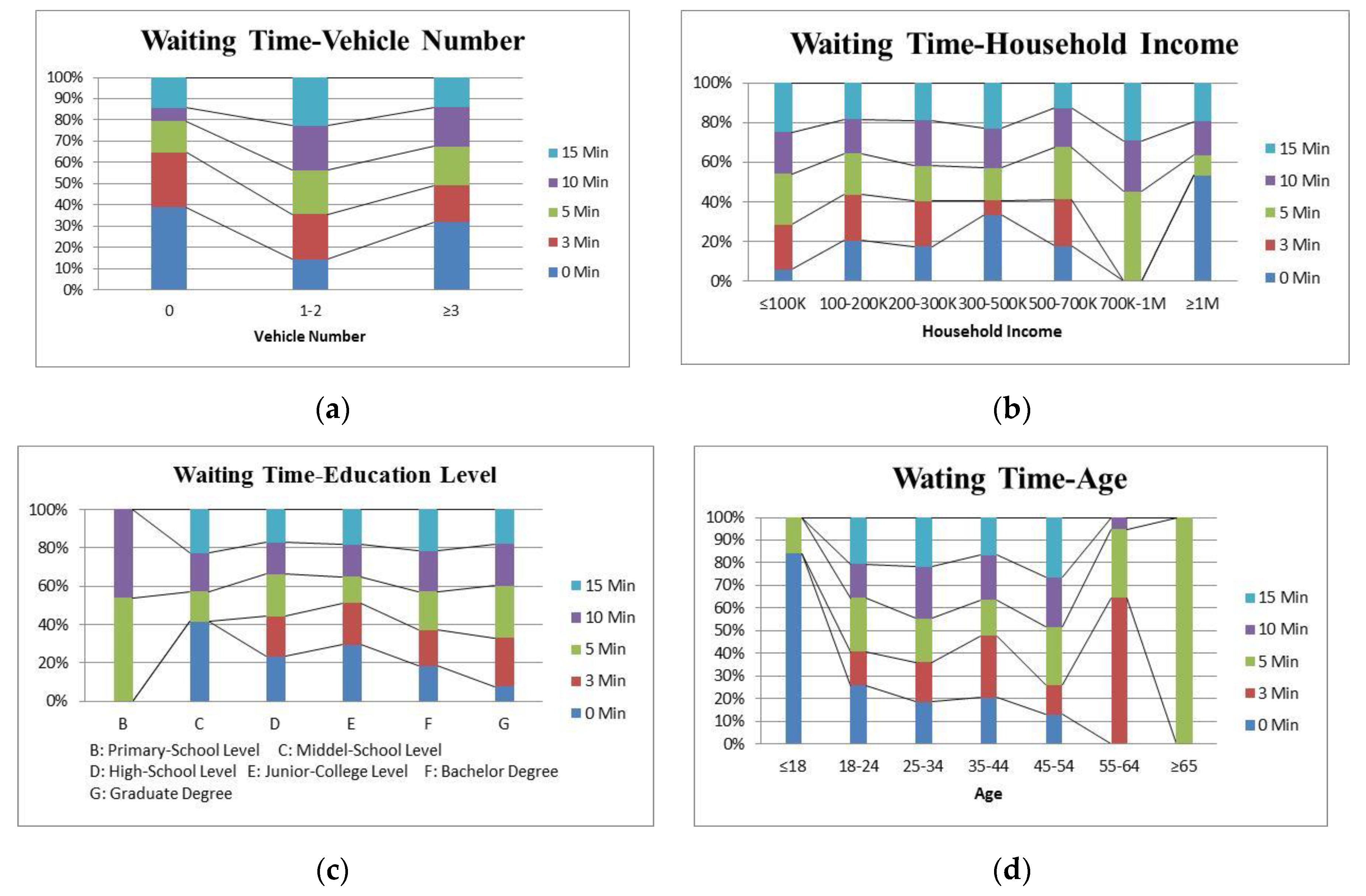
Appendix C.3. BEV Waiting Time

Appendix D. MNL Models for Obtained Electric Driving Range
Appendix D.1. PHEV Obtained Driving Range
| PHEV Driving Range | Coef. | Std. Err. | z | P > z | [95% Conf.Interval] | |
|---|---|---|---|---|---|---|
| Choice 1 = 15 km | ||||||
| Education | −0.1193 | 0.226016 | −0.53 | 0.598 | −0.56228 | 0.323686 |
| Constant | −1.9557 | 1.314935 | −1.49 | 0.137 | −4.53292 | 0.621524 |
| Choice 2 = 25 km | ||||||
| Education | −0.3269 | 0.110558 | −2.96 | 0.003 | −0.54359 | −0.11021 |
| Constant | 0.773935 | 0.630999 | 1.23 | 0.22 | −0.4628 | 2.01067 |
| Choice 3 = 40 km | ||||||
| Education | −0.22858 | 0.110875 | −2.06 | 0.039 | −0.44589 | −0.01127 |
| Constant | 0.291669 | 0.640038 | 0.46 | 0.649 | −0.96278 | 1.546119 |
| Note: Choice 4 (=50 km) is the base outcome | ||||||
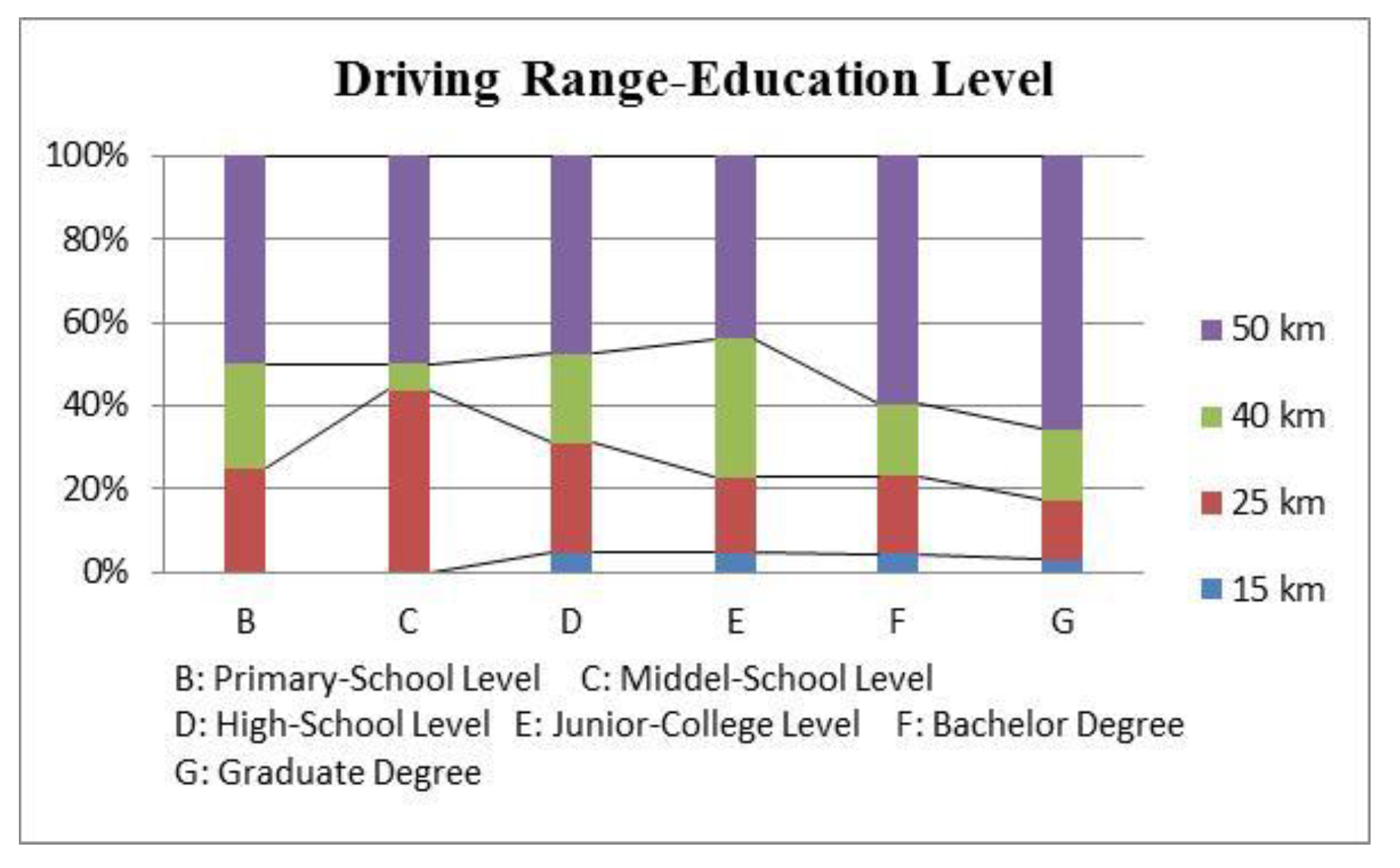
Appendix D.2. BEV Obtained Driving Range
| BEV Driving Range | Coef. | Std. Err. | z | P > z | [95% Conf.Interval] | |
|---|---|---|---|---|---|---|
| Choice 1 = 25 km | ||||||
| VehicleNum | −0.26471 | 0.458154 | −0.58 | 0.563 | −1.16267 | 0.633256 |
| Sex | 1.112341 | 0.441582 | 2.52 | 0.012 | 0.246856 | 1.977825 |
| Education | 0.027177 | 0.21155 | 0.13 | 0.898 | −0.38745 | 0.441808 |
| Age | 0.24949 | 0.233715 | 1.07 | 0.286 | −0.20858 | 0.707563 |
| Constant | −3.21996 | 1.850266 | −1.74 | 0.082 | −6.84642 | 0.406491 |
| Choice 2 = 40 km | ||||||
| VehicleNum | −0.84928 | 0.296627 | −2.86 | 0.004 | −1.43066 | −0.2679 |
| Sex | 0.339754 | 0.283135 | 1.2 | 0.23 | −0.21518 | 0.894689 |
| Education | 0.036362 | 0.126644 | 0.29 | 0.774 | −0.21185 | 0.284579 |
| Age | 0.198158 | 0.146914 | 1.35 | 0.177 | −0.08979 | 0.486104 |
| Constant | 0.913918 | 1.110388 | 0.82 | 0.41 | −1.2624 | 3.090238 |
| Choice 3 = 50 km | ||||||
| VehicleNum | −0.47607 | 0.27227 | −1.75 | 0.08 | −1.00971 | 0.057566 |
| Sex | 0.289116 | 0.273268 | 1.06 | 0.29 | −0.24648 | 0.824711 |
| Education | 0.349421 | 0.131466 | 2.66 | 0.008 | 0.091753 | 0.607089 |
| Age | 0.446453 | 0.140444 | 3.18 | 0.001 | 0.171188 | 0.721718 |
| Constant | −2.24205 | 1.119828 | −2 | 0.045 | −4.43688 | −0.04723 |
| Choice 4 = 80 km | ||||||
| VehicleNum | −0.96999 | 0.439315 | −2.21 | 0.027 | −1.83103 | −0.10895 |
| Sex | 0.16535 | 0.4027 | 0.41 | 0.681 | −0.62393 | 0.954627 |
| Education | 0.561331 | 0.218652 | 2.57 | 0.01 | 0.13278 | 0.989882 |
| Age | 0.445505 | 0.209523 | 2.13 | 0.033 | 0.034849 | 0.856162 |
| Constant | −3.67794 | 1.829451 | −2.01 | 0.044 | −7.2636 | −0.09228 |
| Choice 5 = 100 km | ||||||
| VehicleNum | −0.28215 | 0.327767 | −0.86 | 0.389 | −0.92456 | 0.36026 |
| Sex | 0.773811 | 0.321239 | 2.41 | 0.016 | 0.144195 | 1.403427 |
| Education | 0.213747 | 0.158588 | 1.35 | 0.178 | −0.09708 | 0.524574 |
| Age | 0.403446 | 0.167866 | 2.4 | 0.016 | 0.074434 | 0.732458 |
| Constant | −3.27165 | 1.364242 | −2.4 | 0.016 | −5.94552 | −0.59779 |
| Note: Choice 6 (=150 km) is the base outcome | ||||||

References
- Chen, X.; Zhang, H.; Xu, Z.; Nielsen, C.P.; McElroy, M.B.; Lv, J. Impacts of fleet types and charging modes for electric vehicles on emissions under different penetrations of wind power. Nat. Energy 2018, 3, 413–421. [Google Scholar] [CrossRef]
- Melton, N.; Axsen, J.; Sperling, D. Moving beyond alternative fuel hype to decarbonize transportation. Nat. Energy 2016, 1, 16013. [Google Scholar] [CrossRef]
- Zhuge, C.; Shao, C. Investigating the factors influencing the uptake of electric vehicles in Beijing, China: Statistical and spatial perspectives. J. Clean. Prod. 2019, 213, 199–216. [Google Scholar] [CrossRef]
- Shafie-khah, M.; Heydarian-Forushani, E.; Osório, G.J.; Gil, F.A.; Aghaei, J.; Barani, M.; Catalão, J.P. Optimal behavior of electric vehicle parking lots as demand response aggregation agents. IEEE Trans. Smart Grid 2016, 7, 2654–2665. [Google Scholar] [CrossRef]
- Amini, M.; Islam, A. Allocation of electric vehicles’ parking lots in distribution network. In Proceedings of the 2014 IEEE PES Innovative Smart Grid Technologies Conference (ISGT), Washington DC, USA, 19–22 February 2014; pp. 1–5. [Google Scholar]
- Li, G.; Zhang, X.-P. Modeling of plug-in hybrid electric vehicle charging demand in probabilistic power flow calculations. IEEE Trans. Smart Grid 2012, 3, 492–499. [Google Scholar] [CrossRef]
- Steen, D.; Carlson, O.; Bertling, L. Assessment of electric vehicle charging scenarios based on demographical data. IEEE Trans. Smart Grid 2012, 3, 1457–1468. [Google Scholar] [CrossRef]
- Zhuge, C.; Wei, B.; Dong, C.; Shao, C.; Shan, Y. Exploring the future electric vehicle market and its impacts with an agent-based spatial integrated framework: A case study of Beijing, China. J. Clean. Prod. 2019, 221, 710–737. [Google Scholar] [CrossRef]
- Zhuge, C.; Shao, C. Agent-based modelling of locating public transport facilities for conventional and electric vehicles. In Net. Sp. Econ. 2018, 18, 875–908. [Google Scholar] [CrossRef]
- Daina, N.; Sivakumar, A.; Polak, J.W. Electric vehicle charging choices: Modelling and implications for smart charging services. Transp. Res. Part C Emerg. Technol. 2017, 81, 36–56. [Google Scholar] [CrossRef]
- Daina, N.; Sivakumar, A.; Polak, J.W. Modelling electric vehicles use: A survey on the methods. Renew. Sustain. Energy Rev. 2017, 68, 447–460. [Google Scholar] [CrossRef]
- Corchero García, C. European Electric Vehicle Fleet: Driving and Charging Behaviors; X Congreso de la Asociación Española para la Economía Energética: Madrid, Spain, 2015; pp. 1–11. [Google Scholar]
- Robinson, A.; Blythe, P.; Bell, M.; Hübner, Y.; Hill, G. Analysis of electric vehicle driver recharging demand profiles and subsequent impacts on the carbon content of electric vehicle trips. Energy Policy 2013, 61, 337–348. [Google Scholar] [CrossRef]
- Zoepf, S.; MacKenzie, D.; Keith, D.; Chernicoff, W. Charging choices and fuel displacement in a large-scale demonstration of plug-in hybrid electric vehicles. Transp. Res. Rec. 2013. [Google Scholar] [CrossRef]
- Hill, G.; Blythe, P.T.; Hübner, Y.; Neaimeh, M.; Higgins, C.; Suresh, V. Monitoring and predicting charging behaviour for electric vehicles. In Proceedings of the 2012 IEEE Intelligent Vehicles Symposium (IV), Alcalá de Henares, Spain, 3–7 June 2012; pp. 914–919. [Google Scholar]
- Morrissey, P.; Weldon, P.; O’Mahony, M. Electric vehicle household charging behaviour in Ireland and aims for a carbon neutral electric fleet by 2020. World Rev. Intermodal Transp. Res. 2015, 5, 336–352. [Google Scholar] [CrossRef]
- Kim, S.; Yang, D.; Rasouli, S.; Timmermans, H. Heterogeneous hazard model of PEV users charging intervals: Analysis of four years charging transactions data. Transp. Res. Part C Emerg. Technol. 2017, 82, 248–260. [Google Scholar] [CrossRef]
- Kelley, S.; Kuby, M. On the way or around the corner? Observed refueling choices of alternative-fuel drivers in Southern California. J. Transp. Geogr. 2013, 33, 258–267. [Google Scholar] [CrossRef]
- Brey, J.J.; Brey, R.; Carazo, A.F.; Ruiz-Montero, M.; Tejada, M. Incorporating refuelling behaviour and drivers’ preferences in the design of alternative fuels infrastructure in a city. Transp. Res. Part C Emerg. Technol. 2016, 65, 144–155. [Google Scholar] [CrossRef]
- Kitamura, R.; Sperling, D. Refueling behavior of automobile drivers. Transp. Res. Part A Gen. 1987, 21, 235–245. [Google Scholar] [CrossRef]
- Sun, X.-H.; Yamamoto, T.; Morikawa, T. Fast-charging station choice behavior among battery electric vehicle users. Transp. Res. Part D Transp. Environ. 2016, 46, 26–39. [Google Scholar] [CrossRef]
- Bunzeck, I.; Feenstra, C.F.J.Y.; Paukovic, M. Preferences of Potential Users of Electric Cars Related to Charging—A Survey in Eight EU Countries. 2011. Available online: http://www.d-incert.nl/wp-content/uploads/2011/05/rapportage_ECN.pdf (accessed on 13 November 2017).
- DoE, U. Evaluating Electric Vehicle Charging Impacts and Customer Charging Behaviors—Experiences from Six Smart Grid Investment Grant Projects; Smart Grid Investment Grant Program: Washington, DC, USA, 2016; p. 12. [Google Scholar]
- Yang, Y.; Yao, E.; Yang, Z.; Zhang, R. Modeling the charging and route choice behavior of BEV drivers. Transp. Res. Part C Emerg. Technol. 2016, 65, 190–204. [Google Scholar] [CrossRef]
- Spoelstra, J. Charging Behaviour of Dutch EV Drivers. Master’s Thesis, Utrecht University, Utrecht, The Netherlands, 2014. [Google Scholar]
- Franke, T.; Krems, J.F. Understanding charging behaviour of electric vehicle users. Transp. Res. Part F Traffic Psychol. Behav. 2013, 21, 75–89. [Google Scholar] [CrossRef]
- Kelly, J.C.; MacDonald, J.S.; Keoleian, G.A. Time-dependent plug-in hybrid electric vehicle charging based on national driving patterns and demographics. Appl. Energy 2012, 94, 395–405. [Google Scholar] [CrossRef]
- Tal, G.; Nicholas, M.; Davies, J.; Woodjack, J. Charging Behavior Impacts on Electric Vehicle Miles Traveled: Who Is Not Plugging In? Transp. Res. Record 2014, 2454, 53–60. [Google Scholar] [CrossRef]
- Pearre, N.S.; Kempton, W.; Guensler, R.L.; Elango, V.V. Electric vehicles: How much range is required for a day’s driving? Transp. Res. Part C Emerg. Technol. 2011, 19, 1171–1184. [Google Scholar] [CrossRef]
- Dallinger, D.; Krampe, D.; Wietschel, M. Vehicle-to-grid regulation reserves based on a dynamic simulation of mobility behavior. IEEE Trans. Smart Grid 2011, 2, 302–313. [Google Scholar] [CrossRef]
- Mwasilu, F.; Justo, J.J.; Kim, E.-K.; Do, T.D.; Jung, J.-W. Electric vehicles and smart grid interaction: A review on vehicle to grid and renewable energy sources integration. Renew. Sustain. Energy Rev. 2014, 34, 501–516. [Google Scholar] [CrossRef]
- Greaves, S.; Backman, H.; Ellison, A.B. An empirical assessment of the feasibility of battery electric vehicles for day-to-day driving. Transp. Res. Part A Policy Pract. 2014, 66, 226–237. [Google Scholar] [CrossRef]
- Adamowicz, W.; Louviere, J.; Williams, M. Combining revealed and stated preference methods for valuing environmental amenities. J. Environ. Econ. Manag. 1994, 26, 271–292. [Google Scholar] [CrossRef]
- Kroes, E.P.; Sheldon, R.J. Stated Preference Method: An Introduction. J. Transp. Econ. Policy 1988, 22, 11–25. [Google Scholar]
- Wardman, M. A comparison of revealed preference and stated preference models of travel behaviour. J. Transp. Econ. Policy 1988, 22, 71–91. [Google Scholar]
- Bunce, L.; Harris, M.; Burgess, M. Charge up then charge out? Drivers’ perceptions and experiences of electric vehicles in the UK. Transp. Res. Part A Policy Pract. 2014, 59, 278–287. [Google Scholar] [CrossRef]
- Zhang, Q. The Number of BEVs in Beijing Exceeds 6000. 2014. Available online: http://www.bjrd.gov.cn/xwzx_1/xwkx/yfly/201412/t20141229_142058.html (accessed on 14 May 2015).
- Bierlaire, M. Discrete choice models. In Operations Research and Decision Aid Methodologies in Traffic and Transportation Management; Springer: New York, NY, USA, 1998; pp. 203–227. [Google Scholar]
- Krejcie, R.V.; Morgan, D.W. Determining sample size for research activities. Educ. Psychol. Meas. 1970, 30, 607–610. [Google Scholar] [CrossRef]
- Long, J.S. Regression Models for Nominal and Ordinal Outcomes. In The SAGE Handbook of Regression Analysis and Causal Inference; SAGE Publications Ltd.: London, UK, 2014; pp. 173–204. [Google Scholar]
- Arı, E.; Yıldız, Z. Paralel lines assumption in ordinal logistic regression and analyses aprroaches. Int. Interdiscip. J. Sci. Res. 2013, 1, 8–23. [Google Scholar]
- Williams, R. Ordinal regression models: Problems, solutions, and problems with the solutions. In Proceedings of the German State User Group Meetings, Indianapolis, Indiana, 22 June 2008; Available online: http://www.stata.com/meeting/germany08/GSUG2008-Handout (accessed on 13 March 2019).
- Stata, Mlogit—Multinomial (polytomous) Logistic Regression. 2016. Available online: http://www.stata.com/manuals13/rmlogit.pdf (accessed on 22 March 2016).
- Hosmer, D.W.J.; Lemeshow, S. Applied Logistic Regression; John Wiley & Sons: Somerset, NJ, USA, 2004. [Google Scholar]
- Long, J.S.; Freese, J. Regression Models for Categorical Dependent Variables Using Stata; Stata Press: College Station, TX, USA, 2006. [Google Scholar]
- Kangur, A.; Jager, W.; Verbrugge, R.; Bockarjova, M. An agent-based model for diffusion of electric vehicles. J. Environ. Psychol. 2017, 52, 166–182. [Google Scholar] [CrossRef]
- Department-for-Transport. Driving licence holding and vehicle availability. In National Travel Survey: 2010; Department for Transport: London, UK, 2010. [Google Scholar]
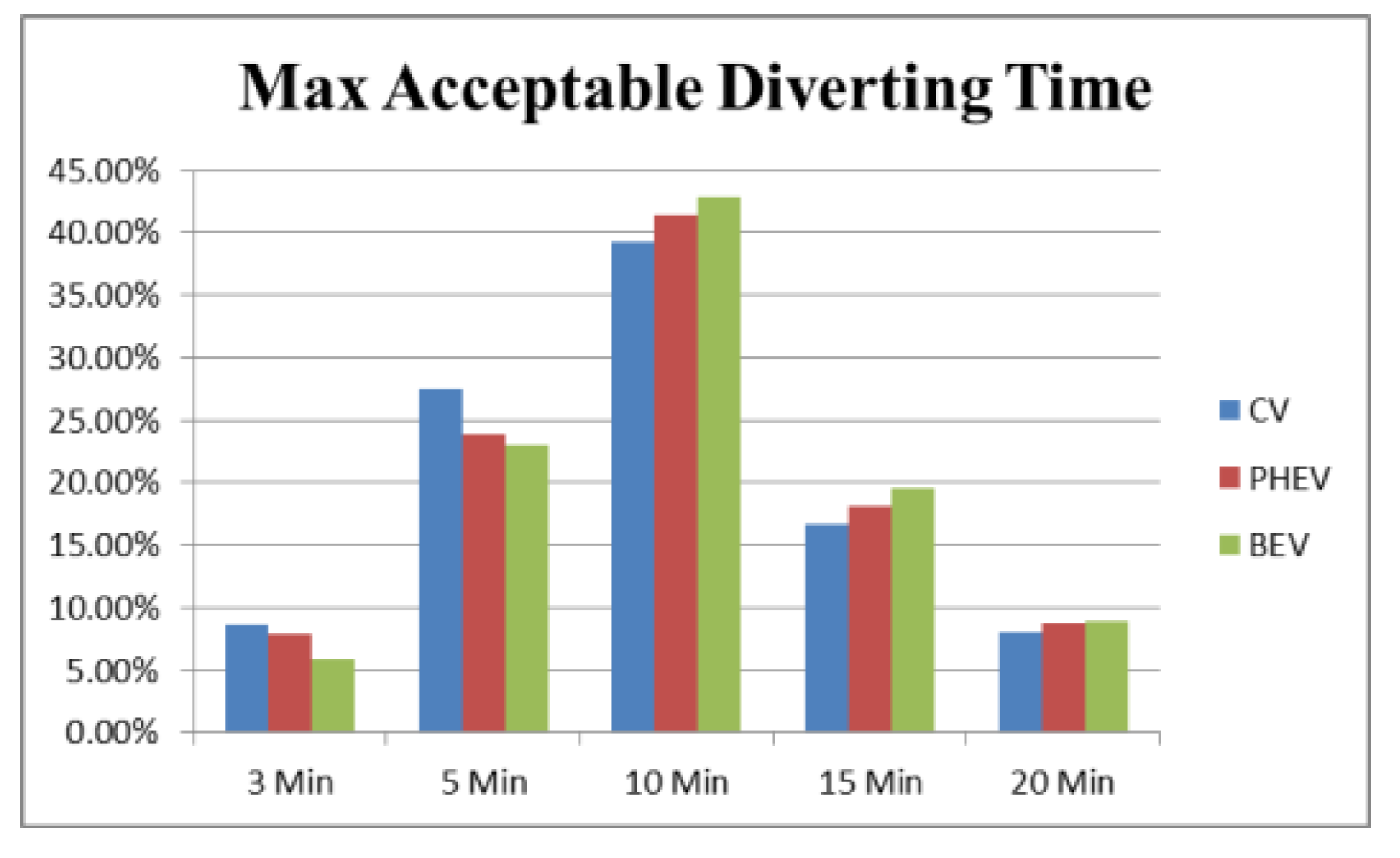

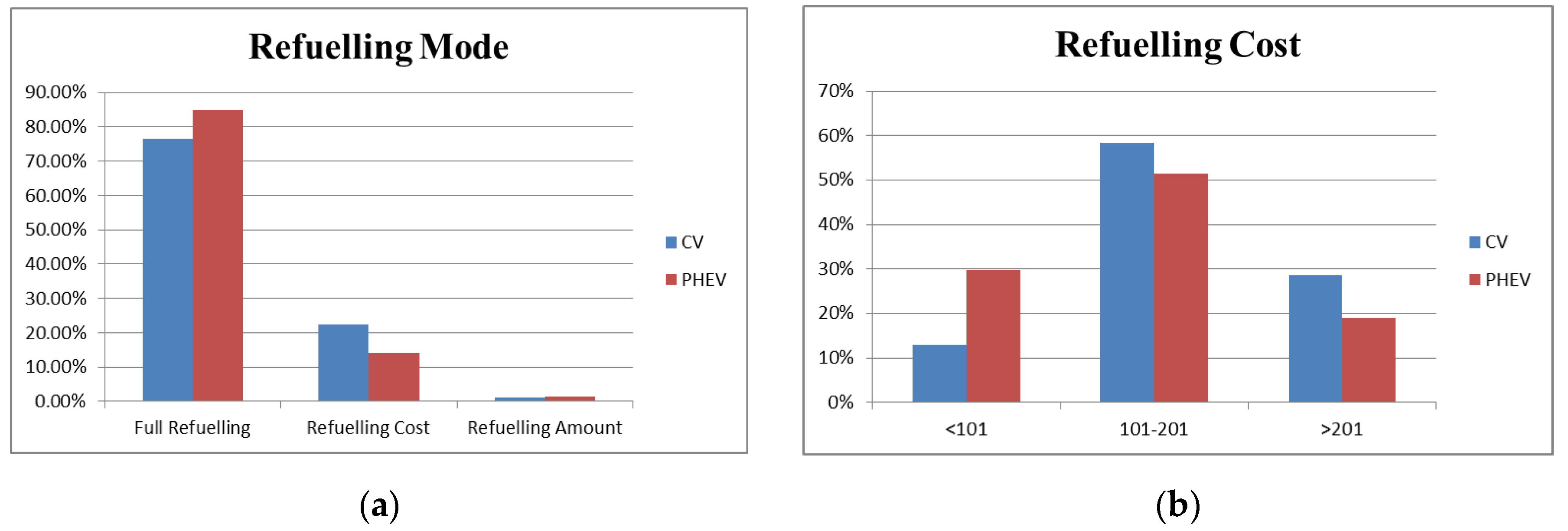

| Questionnaire | Question Types | Description |
|---|---|---|
| Part 1 | Individual attributes | Sex, age, individual monthly income, highest level of education and job type |
| Household attributes | Household income per year, number of driving licenses, number of children, number of vehicles owned, number of household members | |
| Part 2 | Maximum acceptable diverting time | Maximum acceptable diverting time to reach a station for en route refuelling of CV, BEV and PHEV (five choices: 3, 5, 10, 15 and 20 min) |
| Maximum acceptable waiting time | Maximum acceptable waiting time at a station for en route refuelling of CV, BEV and PHEV (five choices: 0, 3, 5, 10 and 15 min) | |
| Refuelling modes | Refuelling modes of CV and PHEV (three choices: Full refuelling, refuelling with a specific cost and refuelling with a specific amount of fuel) | |
| Obtained electric driving ranges | Obtained electric driving ranges of PHEV and BEV (choices for PHEV:15, 25, 40 and 50 km; choices for BEV: 25, 40, 50, 80, 100 and 150 km) |
| Diverting Time | CV | PHEV | BEV | |||
|---|---|---|---|---|---|---|
| Coef. | z value | Coef. | z value | Coef. | z value | |
| Choice 1 = 3 Min | ||||||
| Age | −0.41963 | −1.52 | ||||
| Education | −0.06046 | −0.31 | ||||
| Indincome | 0.289193 | 2.02 | ||||
| Sex | 0.316925 | 0.65 | ||||
| HouIncome | −0.03938 | −0.23 | ||||
| Constant | 0.178504 | 0.33 | 0.226733 | 0.2 | −0.70037 | −0.59 |
| Choice 2 = 5 Min | ||||||
| Age | 0.149489 | 0.82 | ||||
| Education | 0.115799 | 0.71 | ||||
| Indincome | 0.001616 | 0.02 | ||||
| Sex | 0.301393 | 0.84 | ||||
| HouIncome | −0.30466 | −2.06 | ||||
| Constant | 2.050439 | 4.6 | 0.347892 | 0.37 | 0.021403 | 0.02 |
| Choice 3 = 10 Min | ||||||
| Age | 0.073844 | 0.43 | ||||
| Education | 0.069361 | 0.46 | ||||
| Indincome | 0.115878 | 1.19 | ||||
| Sex | 0.374297 | 1.11 | ||||
| HouIncome | −0.12912 | −0.93 | ||||
| Constant | 1.952058 | 4.56 | 1.162434 | 1.34 | 0.349394 | 0.43 |
| Choice 4 = 15 Min | ||||||
| Age | −0.1961 | −1 | ||||
| Education | 0.375028 | 2.08 | ||||
| Indincome | 0.26472 | 2.45 | ||||
| Sex | 0.200319 | 0.53 | ||||
| HouIncome | −0.01908 | −0.13 | ||||
| Constant | 0.792392 | 1.67 | −1.44664 | −1.37 | 0.064271 | 0.07 |
| Note: Choice5 (=20 Min) is the base outcome | ||||||
| Waiting Time | CV | PHEV | BEV | |||
|---|---|---|---|---|---|---|
| Coef. | z value | Coef. | z value | Coef. | z value | |
| Choice 1 = 0 Min | ||||||
| Age | −0.35043 | −1.52 | ||||
| Education | −0.45973 | −2.26 | ||||
| Indincome | −0.02223 | −0.16 | ||||
| Sex | −0.25702 | −0.56 | ||||
| HouIncome | 0.120799 | 0.6 | 0.270253 | 1.46 | ||
| LicenseNum | 1.287613 | 2.05 | ||||
| VehicleNum | 1.044863 | 2.3 | ||||
| Constant | −0.47787 | −0.53 | −0.50472 | −0.32 | −3.59372 | −2.73 |
| Choice 2 = 3 Min | ||||||
| Age | 0.397441 | 2 | ||||
| Education | 0.27118 | 1.34 | ||||
| Indincome | 0.268905 | 2.08 | ||||
| Sex | 0.32638 | 0.85 | ||||
| HouIncome | −0.42975 | −2.15 | −0.37601 | −1.99 | ||
| LicenseNum | −0.35033 | −0.47 | ||||
| VehicleNum | 0.257144 | 0.61 | ||||
| Constant | −0.42191 | −0.53 | −3.12404 | −1.95 | −0.08429 | −0.06 |
| Choice 3 = 5 Min | ||||||
| Age | 0.092518 | 0.62 | ||||
| Education | 0.109257 | 0.77 | ||||
| Indincome | 0.135135 | 1.33 | ||||
| Sex | 0.144033 | 0.46 | ||||
| HouIncome | −0.17409 | −1.16 | −0.12539 | −0.98 | ||
| LicenseNum | −0.35033 | −0.66 | ||||
| VehicleNum | 0.360256 | 1.16 | ||||
| Constant | 0.896102 | 1.42 | −0.73415 | −0.65 | 1.190457 | 1.1 |
| Choice 4 = 10 Min | ||||||
| Age | 0.061202 | 0.42 | ||||
| Education | 0.035678 | 0.26 | ||||
| Indincome | 0.158856 | 1.55 | ||||
| Sex | 0.366878 | 1.17 | ||||
| HouIncome | −0.07556 | −0.5 | −0.00768 | −0.06 | ||
| LicenseNum | −0.25906 | −0.51 | ||||
| VehicleNum | 0.312446 | 1.04 | ||||
| Constant | 0.116474 | 0.18 | −0.25658 | −0.24 | 1.188957 | 1.14 |
| Note: Choice5 (=15 Min) is the base outcome | ||||||
© 2019 by the authors. Licensee MDPI, Basel, Switzerland. This article is an open access article distributed under the terms and conditions of the Creative Commons Attribution (CC BY) license (http://creativecommons.org/licenses/by/4.0/).
Share and Cite
Zhuge, C.; Shao, C.; Li, X. A Comparative Study of En Route Refuelling Behaviours of Conventional and Electric Vehicles in Beijing, China. Sustainability 2019, 11, 3869. https://doi.org/10.3390/su11143869
Zhuge C, Shao C, Li X. A Comparative Study of En Route Refuelling Behaviours of Conventional and Electric Vehicles in Beijing, China. Sustainability. 2019; 11(14):3869. https://doi.org/10.3390/su11143869
Chicago/Turabian StyleZhuge, Chengxiang, Chunfu Shao, and Xia Li. 2019. "A Comparative Study of En Route Refuelling Behaviours of Conventional and Electric Vehicles in Beijing, China" Sustainability 11, no. 14: 3869. https://doi.org/10.3390/su11143869
APA StyleZhuge, C., Shao, C., & Li, X. (2019). A Comparative Study of En Route Refuelling Behaviours of Conventional and Electric Vehicles in Beijing, China. Sustainability, 11(14), 3869. https://doi.org/10.3390/su11143869




